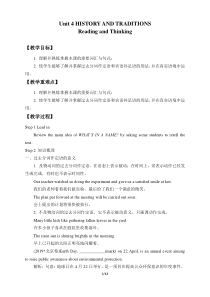 DOC
DOC
【文档说明】人教版(2019)英语必修第二册《Unit 4 History and traditions》全单元教案.docx,共(12)页,1.505 MB,由小喜鸽上传
转载请保留链接:https://www.ichengzhen.cn/view-118975.html
以下为本文档部分文字说明:
1/12Unit4HISTORYANDTRADITIONSReadingandThinking【教学目标】1.理解并熟练掌握本课的重要词汇与句式;2.使学生能够了解并掌握过去分词作定语和宾语补足语的用法,并在真实语境中运用。【教学重难点】1.理解并熟练掌握本课的重要
词汇与句式;2.使学生能够了解并掌握过去分词作定语和宾语补足语的用法,并在真实语境中运用。【教学过程】Step1LeadinReviewthemainideaofWHAT’SINANAME?byaskingsomestudentstoretellthetext.Step2知识梳理一
、过去分词作定语的意义1.及物动词的过去分词作定语,在语态上表示被动;在时间上,常表示动作已经发生或完成,有时也不表示时间性。Ourteacherwatchedusdoingtheexperimentandgaveusasatisfiedsmileatlast.我们的老师看着我
们做实验,最后给了我们一个满意的微笑。Theplanputforwardatthemeetingwillbecarriedoutsoon.会上提出的计划将很快被执行。2.不及物动词的过去分词作定语,它不表示被动意义,只强调动作完成。Manylittlekidsli
kegatheringfallenleavesintheyard.许多小孩子喜欢在庭院里收集落叶。Therisensunisshiningbrightlyinthemorning.早上已升起的太阳正明亮地闪耀着。(2019•北京卷)EarthDay,____
________(mark)on22April,isanannualeventaimingtoraisepublicawarenessaboutenvironmentalprotection.解析:句意:地球日在4月22日举行,是一项旨在
提高公众环保意识的年度事件。2/12mark在这里是“庆祝,纪念(重要事件)”之意,是及物动词,EarthDay与之是被动关系,此处的字面意思是“地球日在4月22日被庆祝”,故用过去分词短语作定语。二、过去分词作定
语的位置1.前置定语一般情况下,单个过去分词作前置定语,即放在所修饰词之前。Thepollutedwaterwastoblameforthespreadofcholera.被污染的水造成了霍乱的传播。Weneededmuchmorequalifiedwo
rkers.我们需要更多的合格的工人。2.后置定语过去分词短语作定语时往往作后置定语,即放在所修饰词之后,它的作用相当于一个定语从句。Heisateacherlovedbyhisstudents.他是一位受学生爱戴的老师。Thebookpublishedtenyearsagoissti
llabestsellertoday.十年前出版的这本书现在仍然是一本畅销书。3.过去分词与现在分词作定语的区别例如:Asweallknow,Chinaisadevelopingcountry.众所周知,中国
是一个发展中国家。Thevisitorisfromadevelopedcountry.这位游客来自一个发达国家。4.过去分词(done)、现在分词的被动语态(beingdone)3/12与动词不定式的被动语态(tobedone)作定语的区别例如:Theb
uildingbuiltlastyearisourclassroombuilding.去年建造的那栋楼是我们的教学楼。Thebuildingbeingbuiltnowisourclassroombuilding.现在正在建造的那栋楼是我们的教学楼。Thebuildingtobebuiltnex
tmonthisourclassroombuilding.下个月将要建造的那栋楼是我们的教学楼。三、常见的过去分词作宾语补足语的情况1.过去分词用在表状态的动词keep,leave等词的后面作宾语补足语。Hepassedaway,leavinghisworksunfini
shed.他去世了,留下他的著作还未完成。2.过去分词用在使役动词have/get和make的后面作宾语补足语。(1)“have/get+宾语+过去分词”表示“让别人做某事”。Hewantstohave/gethiseyesexaminedtomorrow.他明天想去
检查眼睛。JennyhopesthatMr.SmithwillsuggestagoodwaytohaveherwrittenEnglishimprovedinashortperiod.珍妮希望史密斯先生会建议一个好的方法以使她的英语
写作在短期内得到提升。(2)在“make+宾语+过去分词”这种结构中,过去分词表示结果。TheymanagedtomakethemselvesunderstoodbyusingverysimpleEnglish.他们用很浅易的英语来设法使自己被理解。3.感官动词see,
hear,notice,observe,watch,feel,find等后,可用过去分词作宾语补4/12足语。Whenwesawtheroadblockedwithsnow,wedecidedtospendtheholidayathome.当我们看到道路被雪封住后,我们决定在家过假
期。4.表示“意愿;命令”的动词,如like,want,wish,expect,order等可用过去分词作宾语补足语。Themanagerorderedtheworkfinishedattheendofthisweek.经理要求在本周末完成这项工作。5.过去分词用在“with+宾
语+宾补”这一结构中,过去分词与宾语之间是动宾关系。Witheveryproblemsettled,hebegantothinkofajourney.每一个问题解决后,他开始考虑旅行。Step3知识答疑1.核查同学们的自学情况,
收集问题逐步答疑。2.根据课前自学内容,对过去分词作定语和宾补的相关知识进行更详细的补充说明。3.让学生把从课文中找到带有过去分词的句子写出来,并分析过去分词在句子中充当什么成分。Step4小试牛刀用括号内单词
的适当形式填空。1.Inartcriticism,youmustassumetheartisthasasecretmessage______(hide)withinthework.2.MichaelputupapictureofYaoMingbesidethebedtokeephimself_
_____(remind)ofhisowndreams.3.Clairehadherluggage______(check)anhourbeforeherplaneleft.4.Iwassurprisedtofindmyhometown_______(change)
somuch.5.Thosewoodsgaveusallasenseof_______(belong).6.Itcouldbeabitproblematic,_______(legal)speaking.Step5Ho
mework课后练习5/12Unit4HISTORYANDTRADITIONSListeningandSpeaking【教学目标】1.掌握本课的重要词汇与句式;2.引导学生通过课内听力训练,提高听力技巧,锻炼听力水平。【教学重难点】1.本课时
的重要词汇与句式;2.引导学生通过课内听力训练,提高听力技巧,锻炼听力水平。【教学过程】Step1LeadinLookatthephotoonPage37,andthengettheSstoaskandanswerthequestions.1.Whatdoyou
knowaboutthebuildingsinthephoto?2.Whattraditionsofthatcity/countrydoyouknowabout?3.Whyisitimportanttoprotecthistoricbuildingsandculturalt
raditions?ThenhavesomeSssharetheirviewsonthequestions.Step2Shareviewsonhistoricsites1.Beforelistening,gettheS
stolookatsomephotosofQufuinActivity1onPage38.Andask“Whatcanyousayabouttheseplaces?”GettheSstodiscussingroups,andthenaskseveralvo
lunteerstosharetheirviewswiththeclass.2.ListentoaconversationbetweenaBritishtouristandaChinesestudentinQufu,andthenwrited
ownwhattheysayaboutConfucius.6/12Facts/OpinionaboutConfuciusWilliamXiaoKongFinallychecktheanswerswiththeclass.3.Lis
tenagainanddecidewhetherthesestatementsaretrue(T),false(F),ornotmentioned(NM).(1)Listenandjudge,andcheckth
eanswers.1)Confuciussaidthatlearningwithoutunderstandingleadstoconfusion.2)XiaoKongisdoingaresearchp
rojectonConfuciusphilosophy.3)AsoneofConfucius’descendants,XiaoKong’snameisrecordedinthefamilytree.4)DachengHallisthetallestbuildinginQufu.(2)The
ngothroughthequestionasbellow,andchoosetherightanswer.·WhydoyouthinkWilliamsaidhishometownwassimilartoQu
fu?A.Therearefamoushallsinhishometown.B.Therearenotallbuildingsinhishometown.C.Bothplaceshaveafamouspersonwhowasbornthere.D.Hishometowndoesn’tallowot
herbuildingstobemorenoticeablethanthehistoricbuildings.4.Activity4(1)Atfirst,gothroughtheUnderstandidiomswiththeSs.Anidiomi
sanexpressionwhichmeanssomethingdifferentfromthemeaningoftheindividualwords.Someidiomspresentanideaorpaintapicturethatgive
sahintastothemeaning.Otheridiomscanonlybeunderstoodfromthecontextinwhichtheyappear.(2)WritedowntheEnglishidiomsthatareusedinth
econversation.ExplaintheirmeaningsandthinkaboutsomeChineseequivalents.7/125.Discussthequestionsingroups,andthengetsomeSstosharetheiranswers.
(1)WhatdoyouknowaboutConfucius’ideasoneducation?Thinkoftwoorthreeexamples.WhatelsedoyouknowaboutConfuciusand
hisphilosophy?(2)Thinkaboutahistoricsitethatyouhavevisited,andgiveanintroductiontoitshistoryandimportance.Step3Pronunciat
ion1.Readthispartofthepoem“If-”writtenbyBritishpoetRudyardKipling.Noticethelinkingsounds.ThenmarkthelinkingsoundsafterthemodelI
fyoucanmakeoneheapofallyourwinningsAndriskitononeturnofpitch-and-toss,Andlose,andstartagainatyourbeginningsAndneverbreatheawor
daboutyourloss;IfyoucanforceyourheartandnerveandsinewToserveyourturnlongaftertheyaregone,AndsoholdonwhenthereisnothinginyouExcepttheWillwhich
saystothem:"Holdon!"2.Repeatthepoemaftertherecording.Step4Homework课后练习Unit4HISTORYANDTRADITIONSReadingandT
hinking【教学目标】1.理解并熟练掌握本课的重要词汇与句式;2.引导学生通过课内阅读,了解英国的历史,全面培养学生的阅读能力和技巧。3.指导学生按照识记—领会—应用—交际的学习规律,由浅入深、有步骤、有次序地掌握词汇知识
。【教学重难点】1.理解并熟练掌握本课的重要词汇与句式;2.指导学生按照识记—领会—应用—交际的学习规律,由浅入深、有步骤、有次序地掌握词汇知识。8/12【教学过程】Step1LeadinBeforerea
ding(1)Gothroughsomeinformationabouthowtoreadamap.Whenyoulookatamap,thinkfirstaboutwhatthemapshowsandwhatthesymbolsmean.(
2)Thendiscussthequestionsinpairs.Lookatthemapbelow.Whatdoesitshow?Whatisitusedfor?AndattheendhavesomeSssharetheirviewsonthequ
estions.Step2Whilereading1.Readthetextandanswerthequestions.(1)WhatarethefourcountriesoftheUnitedKingdom?Whichtwowereth
efirsttobejoinedtogether?(2)Accordingtothetext,whataretwochiefadvantagesofstudyingthehistoryofacountry?2.Readagainandpayattentiontoseveralpoints.(
1)Theyusethesameflag,knownastheUnionJack,aswellassharethesamecurrencyandmilitarydefence.像拥有同样的货币和国防一样,他们也使用同一面国旗。theUnionJack英国国旗,由英格兰、苏
格兰和爱尔兰的旗帜组成。knownastheUnionJack,过去分词短语作后置定语,修饰前面的名词flag,相当于非限制性定语从句whichisknownastheUnionJack。如:Yang
Liwei,knownasthefirstChineseastronauttogointospace,isregardedasanastronautichero.=YangLiwei,whoisknownasthefirstChineseastronauttogoinspace,i
sregardedasanastronautichero.作为第一个进入太空的中国宇航员,杨利伟被称为航天英雄。单个的过去分词一般用作前置定语。如:Hebecameoneofthewell-knownactorsofhisday.他成为那个时代著名的演员之一。curren
cy货币。英国的货币是英镑(pound),符号是<ERR>。如Youwillneedsomelocalcurrencywhengoingabroad,andofcourseyoucanuseyourcreditcard.出国时你需要准备一些当地的货币,当然你也可以使用
信用卡。【思考】启发学生思考:①如何用英语表达我国的人民币和其他国家的货币单位吗?9/12②想出更多的过去分词前置和后置定语的例子吗?(2)theRomans古罗马人公元前8世纪,古罗马人建立了强大的中央集权国家。公元前58年以后的几年间,罗马统帅恺撒率领大军征服了外高
卢(今法国、比利时等)后,又占领了不列颠岛北部。此后,古罗马的文明传入了不列颠。(3)theAnglo-Saxons盎格鲁—撒克逊人欧洲古代日耳曼人的一支。由盎格鲁和撒克逊人融合而成。公元9世纪,西撒克逊国打败诸国,建立统一的英格兰王国。此后,不列颠岛上的部落逐渐发生融合,形成盎格鲁一撒克逊人,
成为后来英格兰人的主要部族。(4)theVikings北欧海盗维京人,斯堪的纳维亚人的一支。大约8世纪入侵不列颠,来自北欧的挪威和丹麦。(5)theNormans诺曼人诺曼人来自欧洲西北部,1066年诺曼底公爵威廉入侵英国并实现了诺曼王朝对英国的统治。3.Haveth
eSsreadagainandsortouttheinformationaccordingtothetimelineinActivity3.Getthemtocompletethechartbythemselvesandthenchecktheanswerswiththeclass
.4.CompletetheconversationabouttheUKusingthephrasesintheircorrectformsinActivity4.AndthengetsomeSstoshowtheiranswers.Finallychecktheanswerswit
htheclass.5.Workingroups.Discussthequestionsingroups,thenhavesomeSstosharetheirviewswiththeclass.(1)Whyisitim
portanttostudythehistoryandcultureofacountrybeforevisitingit?(2)Whatimportantthingsshouldvisitorsknowaboutbeforetheyco
metoChina?Step3Homework课后练习Unit4HISTORYANDTRADITIONSReadingforWriting【教学目标】1.理解并熟练掌握本课的重要词汇与句式;2.引导学生通过课内阅读,了解爱尔兰的历史传统和美丽风光,引导学生
在情境中10/12体会单词的词性、构成方法、用法,提高学生的美文欣赏能力和词汇运用能力。3.锻炼学生灵活使用学过的词汇或句式描述一个感兴趣的地方或任何有趣的事物。【教学重难点】1.理解并熟练掌握本课的重要词汇与句式;2.锻炼学生灵活使用学过的词汇或句式
描述一个感兴趣的地方或任何有趣的事物。【教学过程】Step1Leadin1.Beforereading(1)TrytoaskonestudenttoretellthehistoryofBritain.(2)Lookatth
epictureinActivity1,andasktheSs:WhatdoyouthinkofIrelandbeforeyoureadingthetext?Whatkindofwordwillyouusetodescribeitfirst?2.AndhavesomeSss
haretheirviewsonthequestions.Step2Whilereading1.Readthetextandanswerthequestions.(1)WhatmakestheIrishcou
ntrysideexcitingandinspiring?(2)WhatarethebestwaystoexperiencesomeIrishtraditionsandculture?(3)Whatisthemeaningof“breatheinthes
weetscentoffreshflowerswhilebirdsgreetthenewdaywiththeirmorningsong”?(4)WhatarethebestwaystoexperienceCh
inesetraditionsandcustoms?GettheSstoreadthetextcarefullyandthenhavesomeSsanswerthemandalsocheckwiththeclass.2.Readagainandlearntoa
ppreciatethissentenceasbellow.Trytounderstandhowtodescribegracefully.Thepeacefullandscapeofthe“EmeraldIsle”an
ditsmanygreencountiesisatruefeastfortheeyes,withitsrollinggreenhillsdottedwithsheepandcattle.“绿宝石(爱尔兰)岛”风光宁静秀美,郡县草木
葱茏,青山连绵起伏,牛羊点缀其中,堪称一场名副其实的视觉盛宴。afeastfortheeyes视觉盛宴,赏心悦目的事物。如:Wewenttoapaintingexhibitionyesterday,whichwasreally
afeastfortheeyes.我们昨天去看画展,那真是一场视觉盛宴。2.AnalysethedescriptiveparagraphinActivity2.11/12(1)Identifyandunderlinetheparagraph’sintroduct
orysentence(s)andtheendingsentence(s).(2)Theparagraphtalksaboutdifferentsensesindifferentplaces.Writethesensesandplacesintheorderthattheyappear.Sen
ses:1____________Places:1____________2____________2____________3____________3____________4____________4____________(3)HavetheS
stoconsideraboutthequestion:“Whatwordsdoesthewriterusetodescribesensorydetails?”Practiceaskingandanswering.3.GothroughActivity3.TelltheSs
:“Usewhatyouhavelearntinthisunittodescribeaninteresting,exciting,orsurprisingplace.”(1)Workinpairs.Chooseoneoftheirfavouriteplace
sandtellapartnerwhytheythinkitisinteresting,exciting,orsurprising.(2)Usethequestionsbelowtodescribethepl
acetheyhavechosen.·Whatcanyousee?·Whatcanyouhear?·Howdoestheplacefeel?·Whatcanyousmell?·Whatcanyoutaste
there?·Whatdoestheplacemakeyouthinkorfeel?(3).Havethemtousetheiranswerstodraftapassageabouttheplace.4.TelltheSstoexchangedraftswith
theirpartner.(1)Usethechecklisttohelpevaluatehis/herdraft.√Doesthewriterstartwithanimage,quote,orquestion?√Isthedescriptionwell-organisedandeasytorea
d?√Hasthewriterincludedsensorydetails?√Doesthewriterusespecificwordsandgiveexamples?√Istheendingeffective?√Canyoufindanygra
mmarorspellingmistakes?(2)Givethecommentstopartnerandaskhim/hertorevisethedraft.12/125.HavetheSsputuptheirpass
ageintheclassroomormakeaclassbookaboutfavouriteplaces.Step3Homework课后练习
 辽公网安备 21102102000191号
辽公网安备 21102102000191号
 营业执照
营业执照